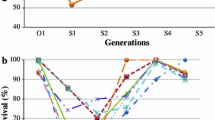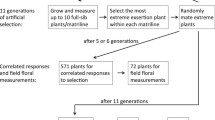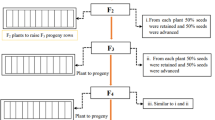Abstract
The genetic control of breeding system in a population of grain amaranth is described here by the estimates of outcrossing rate variation among individuals and their response to mass selection. In the first generation (S0), a single morphological marker locus(R/r) controlling plant pigmentation was used for the estimation of outcrossing rate. A mixture of genotypes RR (red) and rr (green) mixed in equal proportions was grown and all rr plants were progeny-tested for estimating the outcrossing rate (t), using the relationship t=H/p, where H = proportion of heterozygotes (Rr) in the progeny, and p = frequency of alleleR. A full range (0 to 100%) of outcrossing rates was found in the first generation, % MathType!MTEF!2!1!+-% feaafiart1ev1aaatCvAUfeBSjuyZL2yd9gzLbvyNv2CaerbuLwBLn% hiov2DGi1BTfMBaeXatLxBI9gBaerbd9wDYLwzYbItLDharqqtubsr% 4rNCHbGeaGqiVu0Je9sqqrpepC0xbbL8F4rqqrFfpeea0xe9Lq-Jc9% vqaqpepm0xbba9pwe9Q8fs0-yqaqpepae9pg0FirpepeKkFr0xfr-x% fr-xb9adbaqaaeGaciGaaiaabeqaamaabaabaaGcbaGabeiDayaara% Gaeyypa0JaaGimaiaac6cacaaIZaGaaGymaiaacYcacqGHGaaicqGH% GaaicuaHdpWCgaqcamaaBaaaleaacaqG0baabeaakiabg2da9iaaic% dacaGGUaGaaGOmaiaaiwdaaaa!441B!\[{\text{\bar t}} = 0.31, \hat \sigma _{\text{t}} = 0.25\], and the distribution was significantly skewed toward high outcrossing.
A bidirectional mass selection experiment was initiated for high and low outcrossing rates. In the Hi and Lo lines (Generation S1), the rate of outcrossing was estimated using the R locus in addition to two other completely dominant morphological markers(B, G1). Relative sex ratios in the monoecious inflorescences of selected lines were estimated by the number of male flowers per glomerule. Outcrossing rate was significantly different between the Hi and Lo lines, and Lo line exhibited much higher male fertility than the Hi line. Such a response to selection indicated a polygenic control of sex expression, and consequently, of the potential for outcrossing in this population. In the second generation (S2), selection was based on the number of male flowers/glomerule as an index of outcrossing ability. Differences in sex expression between the Hi and Lo lines in S2 generation had 1.0 male flower/glomerule, while the Hi selection individuals had more or less rectangular distribution from 0.1 to 1.0 male flowers/glomerule.
Thus, breeding system in amaranth, as represented by the sex ratios within glomerules and the outcrossing rate parameters, responded to bidirectional selection. Such a genetic component of variation in breeding system has significant implications in the evolution of amaranth species and landraces under domestication.
Similar content being viewed by others
References
Breese, E. L., 1959. Selection for differing degrees of out-breeding in Nicotiana rustica. Ann. Bot. 23: 331–334.
Brown, A. H. D. & Allard, R. W., 1970. Estimation of the mating system in open pollinated maize populations using isozyme polymorphisms. Genetics 66: 133–145.
Frankel, R. & Galun, E., 1977. Pollination mechanisms, reproduction and plant breeding. Springer, Berlin. 281 pp.
Freeman, D. C., McArthur, E. D. Harper, K. T. & Blauer, A. C., 1981. Influence of environment on the floral sex ratio of monoccious plants. Evolution 35: 194–197.
Harding, J. & Tucker, C. L., 1974. Quantitative studies on mating systems. I. Evidence for non-randomness of outcrossing in Phaseolus lunatus. Heredity 19: 369–381.
Holden, J. H. W. & Bond, D. A., 1960. Studies on the breeding system of the field bean. Vicia faba (L.). Heredity 15: 175–192.
Horovitz, A. & Harding, J., 1972. The concept of male outcrossing in hermaphrodite higher plants. Heredity 29: 223–236.
Jain, S. K., 1978. Estimation of outcrossing rates: some alternative procedures. Crop Sci. 19: 23–26.
Kaufman, C. S., 1979. Grain amaranth research: An approach to the development of a new crop. Proc. Second Amaranth Conf., pp. 81–91. Rodale Press, Emmaus.
Knudsen, J. C. & Poulsen, M. H., 1981. Bee visits, crossing frequencies and yield structure of field beans (Vicia faba) with closed flower character. In: R., Thompson (ed.). Vicia faba: physiology and breeding, pp. 317–335. Nijhoff, The Hague.
Moran, G. E. & Brown, A. H. D., 1980. Temperal heterogeneity of outcrossing rates in alpine ash (Eucalyptus delegatensis R. T. Bak.) Theor. appl. Genet. 57: 101–105.
Murphy, J. C., 1978. Pollination in the weedy amaranths. Abstr. Am. Soc. Bot. Meet., 1978.
Murray, M. J., 1940. The genetics of sex determination in the family Amaranthaceae. Genetics 15: 409–431.
Pal, M., 1971. Evolution and improvement of cultivated amaranths. I. Breeding system and inflorescence structure. Proc. natn. Acad. Sci. India 388: 28–37.
Ritland, K. & Jain, S. K., 1981. A model for the estimation outcrossing rate and gene frequencies using independent loci. Heredity 47: 35–52.
Singh, H. B., 1961. Grain amaranthus, buckwheat and chenopods. Ind. Counc. Agric. Res. Cereal Crop Ser. 1: 48 pp.
Walton, P. D., 1968. The use of Amaranthus caudatus in simulating the breeding behavior of commercial Gossypium species. J. Hered. 59: 17–18.
Author information
Authors and Affiliations
Rights and permissions
About this article
Cite this article
Hauptli, H., Jain, S. Genetic variation in outcrossing rate and correlated floral traits in a population of grain amaranth (Amaranthus cruentus L.). Genetica 66, 21–27 (1985). https://doi.org/10.1007/BF00123602
Received:
Accepted:
Issue Date:
DOI: https://doi.org/10.1007/BF00123602




